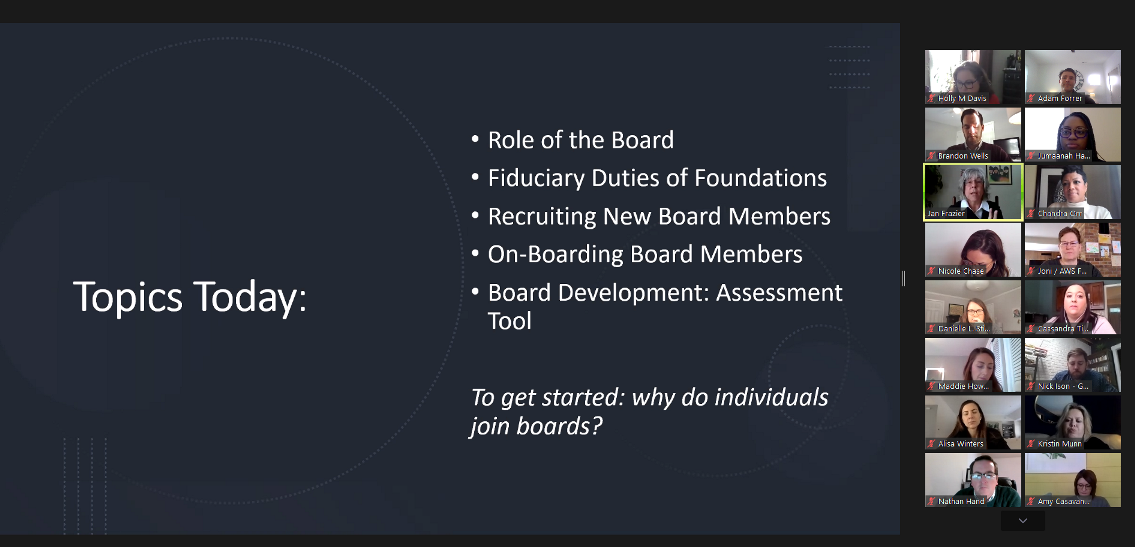Mutz Institute Class Examines Philanthropic Structures

During their second convening held in February, IPA’s Mutz Philanthropic Leadership Institute class examined the structure of philanthropic organizations. We began our day in small groups, sharing what type of organization each class member works for, including whether they are in an urban, suburban, or rural area; how many people work there; what do they do; and what makes their organization different from others.
Jan Breinar Frazier, Planning Plus, presented the role of boards, fiduciary duties of foundations, recruitment, on-boarding, and board development. She shared the reasons why people join boards, including a passion for the mission of the organization, expectation in your professional life, and to help build your resume. The class engaged in a discussion about how their organizations handled the expectation that board members financially support the organization, how and when it is appropriate for the board to get involved with staffing issues, and who should serve as the public face of the organization. It was interesting to see the variety of ways they worked to engage their boards in their missions.
"Mission statements should focus on your impact,” said Jan Frazier. “As staff, you know every day the impact you’re having. But your mission statement should communicate that to a broader audience."
Dr. Bill Stanczykiewicz, assistant dean for external relations, clinical associate professor, and director of the IU Lilly School of Philanthropy Fund Raising School, kicked off philanthropic fundraising with an academic talk about how foundations engage in asset development activities. Dr. Stanczykiewicz underscored philanthropy is voluntary action for the public good. He talked about how to use past giving to inform future gifts. Religion tops the list, followed by education, human services, and donations to foundations. In a study by the Women’s Philanthropy Institute, 54% of US donors did not plan to change their charitable giving in 2020; only 25% planned to increase their giving. Households that decreased their giving did so primarily due to economic concerns. The donor most likely to pause on charitable giving is the single woman who has been disproportionately impacted by the pandemic.
“You are not fundraising; you are inviting them (the potential donor) to join you in making the world a better place. You are in the joy-delivery business,” said Dr. Bill Stanczykiewicz.
We followed up the discussion on charitable giving with an asset development panel featuring Kelly Shrock, president of the Community Foundation of Muncie and Delaware County, Jennifer Danic, president of the Steuben Co Community Foundation, and Brian Yeley, associate vice president of GIFT planning Services at IU Foundation and vice chair of Community Foundation of Bloomington and Monroe County. Moderated by Jen Pendleton of Aly Sterling Philanthropy, the panel shared their experiences with cultivating donors all the way through the stewardship of their supporters. Class members were particularly interested in cross philanthropic cooperation between a local foundation (like a community foundation) and a nearby university or business. The panelists talked about developing trust with their donors to ensure their gifts go to the greatest use.
“Being a friend. Relaxing and caring for these folks (donors) as I would my family,” said Brian Yeley.
We wrapped up our day with a facilitated conversation with John Mutz, program namesake and author of the book Fundraising for Dummies. When asked what key takeaways he had learned in his years of fundraising, Mutz said:
- Fundraising is undersold as a profession in the nonprofit world. However, it is a noble endeavor and it should have a better reputation.
- The most important tool is the prospective donor list. It is critical to keep it up to date.
- Acknowledge the giver and say thank you. It is another contact with the donor and a chance to give them another task.
- Donors must make sense to the philanthropic mission; pair fundraising asks with donor objectives.
The group will next convene for Foundations on the Hill activities in March.
